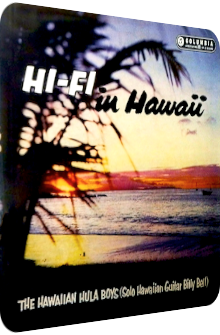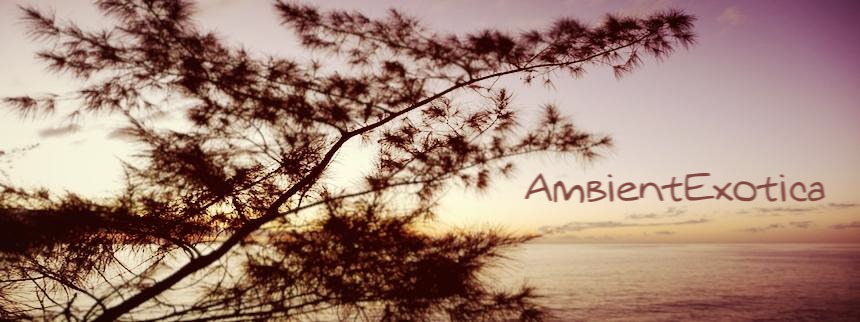
Hawaiian Hula Boys
Hi-Fi In Hawaii
1958
Hi-Fi In Hawaii is a record full of strange particularities, and the first one is already delivered right from the get-go with a glimpse at the band name. Who would call themselves Hawaiian Hula Boys? Notwithstanding Warren Zevon’s eponymous composition, do hula boys even exist fo real? Do tourists long for a dreamy sunset at Waikiki Beach so that they can observe the silhouettes of sexy hula… boys? Come on! Be that as it may, the Hawaiian Hula Boys existed for a short period of time. Comprising of session musicians with steel guitarist Billy Bell at the helm, their one and only full-length LP Hi-Fi In Hawaii is released in 1958 on Columbia Records during the peak of both the tourism craze and the consumer-related kick-off of the stereo recording technique. 12 interpretations of Hapa Haole classics and a few less considered artifacts are presented here.
However, here comes the second alienating – and potentially intriguing – twist: although ukuleles and steel guitars are featured in every arrangement, this is not a stereotypical album from Hawaii thanks to the adamant inclusion of accordions, reeds and brass instruments. The preferred genre of the collective is Dixieland! Billy Bell and his Hawaiian Hula Boys reverse-engineer the standard formula used in many of the songs. Instead of ennobling the Hawaiian breezes with those misplaced instruments, they start with the Dixieland structure and add the ingredients of Hawaii to them. The result is not entirely otherworldly, but remarkable enough to even bewilder those listeners who have literally heard the whole spectrum of Exotica and its related genres. The targeted niche thus becomes even more narrowed down. When such incompatible styles clash, there is still a chance that some great interpretations come out of it, accidentally or not. I do not rest my case yet, for this is just the beginning.
Is it an appropriate way to immediately launch a Hawaiian album with a Dixieland flavor? And to make matters more complicated, with a tune which is called Honolulu? Listeners who have elbowed their ways through hundreds of Hawaiian themed albums will still be dazzled due to this particular weirdness, which, in hindsight, makes things much more interesting though. Honolulu is written by Harry Warren for the movie of the same name, and the Hawaiian Hula Boys take this morphogenetic code and place it in a jocular helix of polyphonous trumpets and accordions. Were it not for Billy Bell’s steel guitar twangs with their archetypically warped Hawaiian elasticity, this tune would have been one of the weirdest exotic tunes to ever appear on such an LP… even by Exotica standards.
Ralph Rainger’s and Leo Robin’s Blue Hawaii takes the album back to Hawaiian waters. While there are brass accents aplenty, they are not in the limelight. Launching with sun-soaked ukulele licks which take over the rhythm, the glitzy steel guitar pierces through the accordion mirage, the famous melody is always carved out well. The percussion is revved up in the chorus, but it is unfortunately no Latin instruments rather than devices taken from a classic drum kit.
Cliff Friend‘s and Charles Tobias’ Trade Winds is next and is, in short, an affront, for it reminds of the schmaltzy chintziness of Billy Vaughn’s ultra-successful but badly-aged arrangements of Hawaiian tunes in Blue Hawaii (1959) and Sukiyaki (1961). The trumpets are really too syrupy and their tones too prolonged. Even Billy Bell’s steel guitar cannot lessen their impetus. On the plus side of the spectrum are the short glockenspiel tittles, the short solo appearances of a clarinet and the comparably upbeat rhythm ukulele. Ben Black’s and Neil Moret’s Moonlight And Roses might carry an eminently dreamy title, but is actually an uplifting and successfully arranged title. The rhythm ukulele is greatly carved out, the four-note motif on the trumpets is positively quirky and designedly playful, and the stretched accordion chords are genuinely warm and do not feel outdated at all. Bell’s steel guitar is used as an accentuating device only, allowing the spirit of Hawaii to waft through this carefree ditty.
While Harry Ruby’s When You Dream About Hawaii ventures back into the metropolitan Dixieland sound during its kick-off phase, but manages to turn back to an delightful entanglement of the steel guitar with the rhythm ukulele that is only occasionally perturbed by the reeds and brass devices, Alfred Newman’s Blue Tahitian Moon is presented in a way which would surely leave the composer aghast. Presented with a gargantuan choir and washes of strings on Newman’s collaborative effort with Ken Darby called Ports Of Paradise (1960), the Hawaiian Hula Boys make a blazing Polka out of this piece. The accordion is omnipresent, the brass instruments and clarinets unite in full force, even the glockenspiel turns pale and ashen. The short nods to Moon Of Manakoora (which was co-written by Alfred Newman as well, so it’s fair game) provide nice “aha moments,” but the rest is a blur. A Polka miasma.
Side B opens with an interpretation of Johnny Noble‘s vision of Hawaiian War Chant, and even though the Hawaiian Hula Boys neglect the use of heavy drums as it is usual in most renditions of this song, their fast-paced Dixieland critter works well thanks to the fast tempo. The steel guitar is only of secondary importance, this is all about the accordion, clarinet and a unnervingly pesky dirtiness of a harsh muted saxophone. The delivery of energy transpires not by the means of drums but many textures and fast rhythms. Quite a success, as curious this may sound. Harry Owens’ To You Sweetheart is another one of the better arrangements and largely Hawaiian, with Billy Bell and his spacey licks in the spotlight, only traces of accordion tones compared to the other instances and last but not least the sparkling effulgence of glockenspiels. Neither essential nor alienating, just good.
Whereas Pagan Love Song by Nacio Herb Brown and Arthur Freed places both accordion spirals and accordion serpentines next to a swinging ukulele groove and mountainous steel guitar prowess, Sing Me A Song Of The Islands by Mack Gordon and Harry Owens decelerates the tempo and creates the ultimate Hapa Haole tune of the album texture-wise, with magnanimous washes of steel guitars and ukuleles during most of its runtime. Clarinet and accordion are present but appear only infrequently. Percy Wenrich’s Moonlight Bay opens with a mellowly warbling Pagan flute that reappears time and again. In addition, the Hawaiian Hula Boys make plenty of use of the glockenspiel in order to mimic the glowing moonlight that shines down on the silky steel guitar. This is another good tune, albeit not particularly nocturnal. Percy Wenrich wrote this composition in 1912, and for the finale, the collective travels even further back in time to – you’ve probably guessed it – Aloha Oe, envisioned in 1878 by Queen Liliuckalani. There is not much to say about this rendition: the ultimate Hapa Haole hymn entangles the steel guitar lead melody with languorous ukulele placentas and scents of accordions. Nothing particularly special in the oversaturated market of ephemeral Aloha Oe takes.
While not a preciously gleaming Hapa Haole artifact per se, Hi-Fi In Hawaii has its little merits, although their effulgence has become pale over the course of the decades. The primary reason for the record’s existence, the proud presentation of the latest stereo equipment in a bachelor den during coffee time, causes shrugged shoulders at best nowadays. In this regard, the album succeeded back then and fails miserably today. Not one of Earth’s billions of people will spin this record for the originally intended purpose anymore. That said, there is a certain, very peculiar seal of quality baked into the sound waves. The many Dixieland-oriented arrangements are a bewildering shtick, but these are only the base frame for the Hawaiian elements to shine, i.e. Billy Bell’s steel guitar and the ukulele accompaniment. Production tactics like this are still valid today: using a certain genre or style as the fundament and then grafting the counterpoints onto this riverbed. Jazz standards with birdcalls are both normal to and appreciated by the ears of the Exotica aficionado, as are orchestra string-fueled phantasmagorias with Latin percussion instead of the common timpani and kettle drums.
Hi-Fi In Hawaii does exactly the same thing, only its starting point differs, and that is the style of Dixieland. Clarinets and trumpets are mercilessly ubiquitous in each and every arrangement, making the clash with the equally ever-present Hapa Haole ingredients an interesting one. I cannot help it but think of this ensuing hodgepodge as strange and overly weird, but once Hawaiiana rules over this particularly North American sound, some sort of gleeful enchantment builds up. The interpretations of Moonlight Bay, Sing Me A Song Of The Islands or To You Sweetheart augment the vehemence of the stringed instruments and are hence among the better ones. Here, Hapa Haole is accentuated by Dixieland, and not vice versa. In the end, Hi-Fi In Hawaii is a non-essential record that can be largely skipped by the Exotica connoisseur. You don’t miss anything particularly valuable. Still, those who insist to check it out can do just that with ease: the record has been remastered in 2010 by Hallmark and is available in digital form at Amazon MP3, iTunes and other music stores.
Exotica Review 239: Hawaiian Hula Boys – Hi-Fi In Hawaii (1958). Originally published on Jul. 20, 2013 at AmbientExotica.com.
